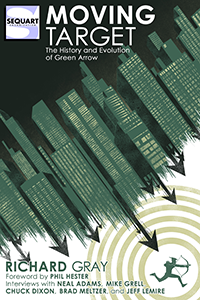The cover of the new issue of Descender is adorned by a character who is rapidly becoming the “Chewbacca” of the series, “Driller”. Driller is exactly what he says he is: a robot that drills rock in a mining operation. But Driller has a very strong sense of loyalty and dignity. His oft-used phrase, “Driller is a Killer!” is directed at humans, who he has grown to see as a threat to any robot. It’s quite touching to see how this gigantic and simple-minded character responds to little TIM-21, the robot boy around whom so much of the drama of Descender revolves, with a sense of protectiveness that borders on parental, but he also responds to TIM’s commands. If he were played by a human, it would be Andre the Giant. That’s how lovable the character is.
It’s equally important to note that, despite what may sound like a sentimental and “children’s movie” device, not to mention artist Dustin Nguyen’s bright white motif throughout, this is still quite a dark book. Only the Captain of the science team sent to recover TIM-21, Telsa, really seems to acknowledge how bad things are in the galaxy, however. Dr Quon is a bit of shell: he’s focused on the technical problem but the lingering guilt he feels over his operating system architecture forming the nucleus of the “Harvesters”, the robots that tried to wipe out humanity. Telsa, as we learn more about her in this issue, has very personal stakes in the investigation.
Telsa and Dr Quon work with TIM-21
That investigation, by the way, finally gets going here in issue #4. The mission is simply to figure out why TIM carries the “codex” and why he’s the only one, other than the Harvesters, who carried it. Then, the corollary would be to determine how the Harvesters went from being robots to, well, harvesting. This second meta-question is what seems to be reflected in the character of Driller. Here’s a machine that’s very powerful, with an autonomous will, that reacts to the world around it with small-scale logical decisions that make sense in that context. For example, Driller wasn’t programmed to kill humans, but the only humans it has seen for years have been actively trying to kill it. (These are the “scrappers”, sort of anti-robot bounty hunters.) Therefore, Driller reasons from the specific to the general: these humans are trying to kill me, ergo all humans are trying to kill me. This is a conundrum that science fiction has dealt with before when it comes to robots, that they seem to lack the mental flexibility of humans, relying on their own big, goal-seeking programs with specific and sometimes incongruous imperatives. HAL-9000 is another example. In that case, a machine was told to lie, and couldn’t, because that order conflicted with a basic imperative of its programming, which was to present all data without falsification. HAL went literally insane, and any reader or viewer of 2001: A Space Odyssey knows where it goes from there. Driller is illustrating this principle on a small scale. The Harvesters illustrated it, possibly, on a large scale. The challenge facing Captain Telsa and Dr Quon is to fill in the gaps.
TIM deals with the good-hearted but simple-minded Driller
This may all sound very philosophical but worry not: Descender has ample science fiction thrills and spills in every issue, this one included. There are gun battles and a truly innovative space dogfight to boot, with Nguyen’s art, sometimes sketched, sometimes with full-rendered painterly panels, amazing throughout. In this sense, Descender is doing what every great space fiction story needs to do: it succeeds on the three levels of character, world-building and philosophy, and all the while being extremely clear and well-paced. After four issues, we can declare it another triumph for Jeff Lemire, and look forward to seeing where the story and characters will take us.





















































